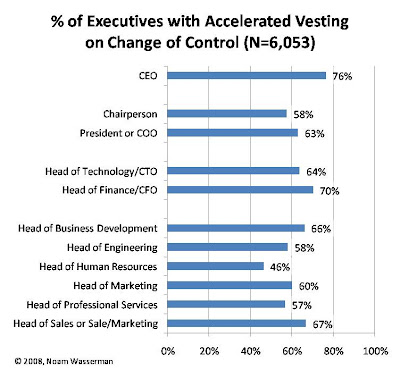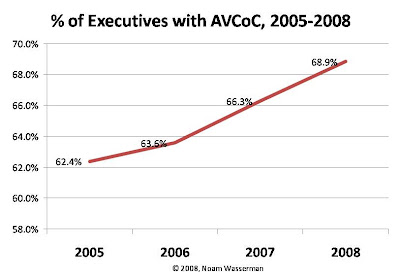Unlocking Your Golden Handcuffs: How Common is Accelerated Vesting on Change of Control? - 8/31/08
Sunday, August 31, 2008
Unlocking Your Golden Handcuffs: How Common is Accelerated Vesting on Change of Control?
http://founderresearch.blogspot.com/2008/08/unlocking-your-golden-handcuffs-how.html
"I'm negotiating my equity-compensation package. How frequently do people get accelerated vesting on change of control?"
In private ventures, vesting of equity stakes is the major form of golden handcuffs (see posts here, here, and here) used to keep executives at their ventures. However, other terms, such as accelerated vesting on change of control (AVCoC), can shorten those vesting periods. (See Brad Feld’s description of AVCoC in the middle of this post, or the VentureHacks overview here.)
I
recently got an email from a serial entrepreneur who has been brought
on as the head of finance and operations in a mobile-services start-up.
One of his questions was: How often do new-venture executives get AVCoC? If
it’s not common for them to get it, he wouldn’t push for it and would
focus his negotiating leverage on another term, but if it’s common, he
wanted to push hard for it. (He felt that the start-up might be the
subject of M&A activity in the future, and had already experienced
working for a large company after a prior venture of his had been
acquired.)
I decided to dive into our fresh CompStudy
data on equity terms to examine how common AVCoC is within new-venture
management teams. I took a look at three levels of data: What is the
overall percentage of executives receiving AVCoC? Does the percentage
differ by level in the organization (e.g., CEO vs. other C-level
executives vs. VP-level executives)? And has the percentage been
changing over the last few years?
For these analyses, I combined our 2005, 2006, 2007, and 2008 IT datasets, which gave me a total of 6,053 executives from 1,202 private ventures.
Overall, the percentage of executives receiving AVCoC was 65.5%. However, as shown in the chart below, the percentage varied from a high of 76.4% for CEOs down to 46.3% for the Head of Human Resources. (I only show the positions for which I had at least 100 data points.)
Over time, the percentage has been steadily increasing.
As shown below, in 2005, 62.4% of executives received AVCoC, but by
2008, it had steadily increased to 68.9%. This increase was relatively
consistent across the positions in the chart above.
Questions:
- When you were in a similar position, how much did you push (or not push) to receive AVCoC? Why?
- There
are good reasons why many boards and investors do not want to give
executives AVCoC (some of which are covered towards the bottom of Brad Feld's post). In your experience, what arguments are most and least effective for getting boards to give it? - Did the strength of those arguments differ by whether the person was a founder vs. a non-founder? By the executive's position (e.g., C-level vs. VP-level person, as per the first chart above) or other characteristics?
- Any thoughts on the increase in AVCoC from 2005-2008 (as per the second chart above)?
| Topic | Replies | Likes | Views | Participants | Last Reply |
|---|---|---|---|---|---|
| RSUs & McDonalds CEO Sex Scandal | 0 | 0 | 243 | ||
| ESPPs Provided Big Gains During March-June Market Swings | 0 | 0 | 231 | ||
| myStockOptions.com Reaches 20-Year Mark | 0 | 0 | 256 |